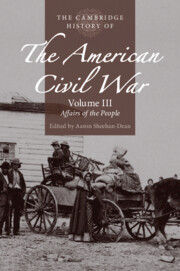Book contents
- The Cambridge History of the American Civil War
- The Cambridge History of the American Civil War
- The Cambridge History of the American Civil War
- Copyright page
- Contents
- Plates
- Figures
- Contributors to Volume III
- Note on the Text
- Part I Values
- 1 Wartime Masculinities
- 2 Northern Women and the Civil War
- 3 Southern Women and the Civil War
- 4 Religion in the Civil War Era
- 5 Economic and Social Values in the Civil War
- Part II Social Experience
- Part III Outcomes
- Index
- Plate Section (PDF Only)
- References
1 - Wartime Masculinities
from Part I - Values
Published online by Cambridge University Press: 11 October 2019
- The Cambridge History of the American Civil War
- The Cambridge History of the American Civil War
- The Cambridge History of the American Civil War
- Copyright page
- Contents
- Plates
- Figures
- Contributors to Volume III
- Note on the Text
- Part I Values
- 1 Wartime Masculinities
- 2 Northern Women and the Civil War
- 3 Southern Women and the Civil War
- 4 Religion in the Civil War Era
- 5 Economic and Social Values in the Civil War
- Part II Social Experience
- Part III Outcomes
- Index
- Plate Section (PDF Only)
- References
Summary
Civil War soldiers marched home in 1865 as changed men. No longer holiday soldiers, they were now seasoned veterans. In “The Return of the Heroes,” poet Walt Whitman celebrated the “worn, swart, handsome, strong” men who had been made from the “stock of homestead and workshop,” hardened by the “long campaign and sweaty march,” and inured to the “hard-fought, bloody field.” Disease or marching had enervated all; shot and shell had maimed some and shaken others. Whitman nevertheless projected a vision of regenerative masculinity. The immortal ranks tramping through the poem’s stanzas displayed a manliness grounded in the work of the antebellum era, transformed by the experiences in war, and redeemed by the agricultural pursuits of the postwar years. Whitman’s poem serves as a reminder that nineteenth-century Americans thought deeply about what made a man and recognized masculinity’s mutability.
- Type
- Chapter
- Information
- The Cambridge History of the American Civil War , pp. 3 - 24Publisher: Cambridge University PressPrint publication year: 2019



